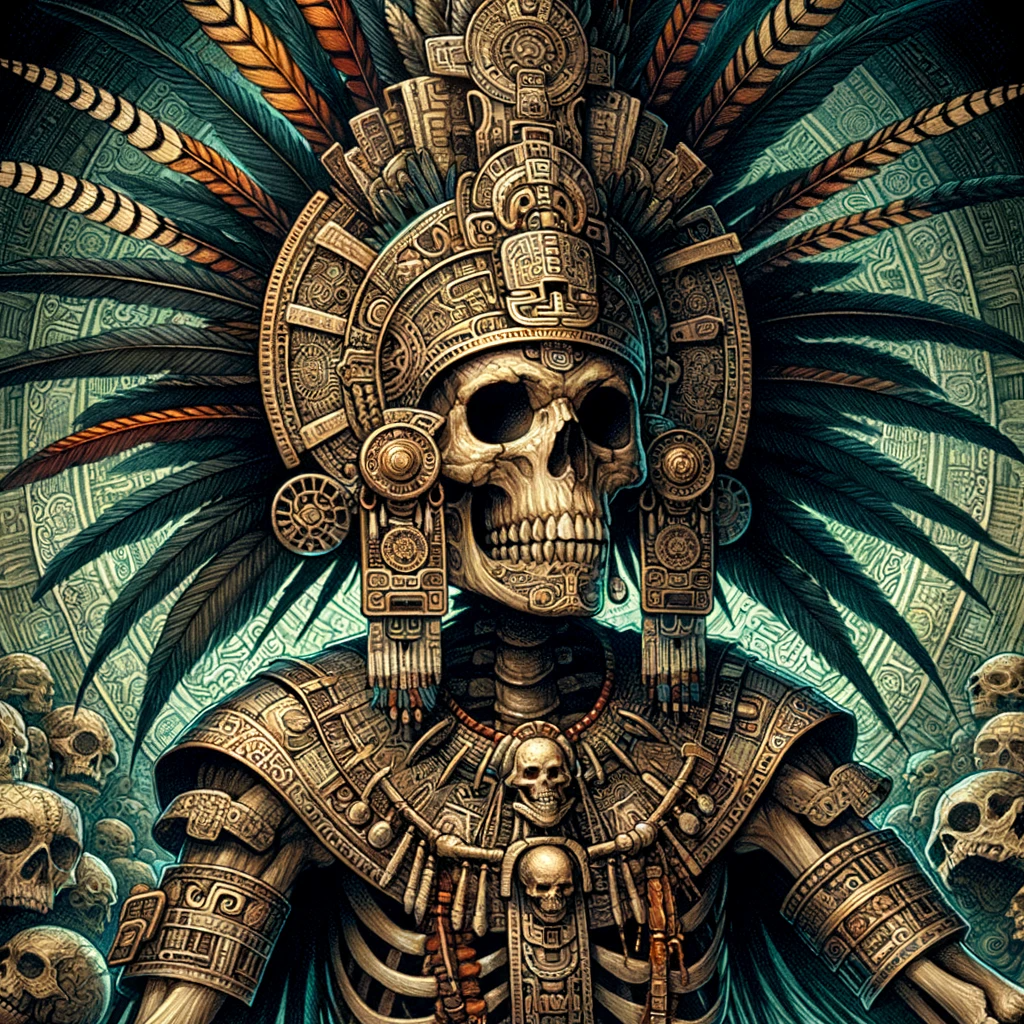
In the rich tapestry of Aztec mythology, Mictlantecuhtli stands as a prominent and fascinating figure. As the Lord of Mictlan, the lowest and northernmost section of the underworld, he held a significant role in Aztec religious and cultural beliefs.
Origins and Mythology
Mictlantecuhtli, whose name translates to "Lord of Mictlan," was a major deity in the Aztec pantheon. He ruled over Mictlan, the destination of the dead who did not die a warrior's death or from childbirth (both of which led to different afterlives). His wife, Mictecacihuatl, known as the "Lady of the Dead," reigned alongside him.
In Aztec mythology, Mictlantecuhtli was often depicted as a blood-spattered skeleton or a person wearing a skull mask. This terrifying image underscored his connection to death and the dead. According to myth, the gods Quetzalcoatl and Tezcatlipoca created the world from the dismembered body of the primordial sea monster, Cipactli. To populate this new world, they needed the bones of the old one, which were kept by Mictlantecuhtli in Mictlan. Through cunning and trickery, Quetzalcoatl managed to steal these bones, although Mictlantecuhtli's attempt to stop him led to the bones being broken and scattered, which, according to myth, explains why humans come in different sizes.
Worship and Rituals
The Aztecs held a cyclical view of the universe and believed in the importance of maintaining cosmic balance through rituals and human sacrifices. Mictlantecuhtli, being a god of the dead, was a significant figure in these rituals. The Aztecs believed that offerings to Mictlantecuhtli and other deities would ensure the continuation of the world and the natural order.
Priests who served Mictlantecuhtli often adorned themselves in his imagery, wearing cloaks decorated with bones and skulls. During certain festivals, they would enact rituals symbolizing death and rebirth, reflecting the Aztec belief in the cyclical nature of life.
Influence on Aztec Culture
The influence of Mictlantecuhtli extended beyond religious rituals. He played a role in the Aztec understanding of the cosmos and the afterlife. The journey to Mictlan was believed to be a treacherous one, taking four years to complete. The dead were equipped with offerings to aid them in this journey, which included items such as jade beads and, most importantly, dogs, which were believed to guide the souls through Mictlan.
Legacy
The legacy of Mictlantecuhtli endures in modern Mexico through cultural celebrations like the Day of the Dead (Día de Muertos). While this holiday has its roots in indigenous Mexican beliefs, it has evolved and merged with Catholic traditions. The imagery of skulls and the celebration of the dead, while not directly tied to Mictlantecuhtli, echo the ancient themes and beliefs associated with the Aztec Lord of the Dead.
Conclusion
Mictlantecuhtli's role as the Lord of the Dead made him a deity of immense importance in the Aztec pantheon. His representation of death and the afterlife encapsulates the Aztecs' complex understanding of and respect for the cycle of life and death. As modern cultures continue to celebrate and remember the dead, the echoes of Mictlantecuhtli's influence resonate, reminding us of the rich and multifaceted mythology of the Aztecs.
Origins and Mythology
Mictlantecuhtli, whose name translates to "Lord of Mictlan," was a major deity in the Aztec pantheon. He ruled over Mictlan, the destination of the dead who did not die a warrior's death or from childbirth (both of which led to different afterlives). His wife, Mictecacihuatl, known as the "Lady of the Dead," reigned alongside him.
In Aztec mythology, Mictlantecuhtli was often depicted as a blood-spattered skeleton or a person wearing a skull mask. This terrifying image underscored his connection to death and the dead. According to myth, the gods Quetzalcoatl and Tezcatlipoca created the world from the dismembered body of the primordial sea monster, Cipactli. To populate this new world, they needed the bones of the old one, which were kept by Mictlantecuhtli in Mictlan. Through cunning and trickery, Quetzalcoatl managed to steal these bones, although Mictlantecuhtli's attempt to stop him led to the bones being broken and scattered, which, according to myth, explains why humans come in different sizes.
Worship and Rituals
The Aztecs held a cyclical view of the universe and believed in the importance of maintaining cosmic balance through rituals and human sacrifices. Mictlantecuhtli, being a god of the dead, was a significant figure in these rituals. The Aztecs believed that offerings to Mictlantecuhtli and other deities would ensure the continuation of the world and the natural order.
Priests who served Mictlantecuhtli often adorned themselves in his imagery, wearing cloaks decorated with bones and skulls. During certain festivals, they would enact rituals symbolizing death and rebirth, reflecting the Aztec belief in the cyclical nature of life.
Influence on Aztec Culture
The influence of Mictlantecuhtli extended beyond religious rituals. He played a role in the Aztec understanding of the cosmos and the afterlife. The journey to Mictlan was believed to be a treacherous one, taking four years to complete. The dead were equipped with offerings to aid them in this journey, which included items such as jade beads and, most importantly, dogs, which were believed to guide the souls through Mictlan.
Legacy
The legacy of Mictlantecuhtli endures in modern Mexico through cultural celebrations like the Day of the Dead (Día de Muertos). While this holiday has its roots in indigenous Mexican beliefs, it has evolved and merged with Catholic traditions. The imagery of skulls and the celebration of the dead, while not directly tied to Mictlantecuhtli, echo the ancient themes and beliefs associated with the Aztec Lord of the Dead.
Conclusion
Mictlantecuhtli's role as the Lord of the Dead made him a deity of immense importance in the Aztec pantheon. His representation of death and the afterlife encapsulates the Aztecs' complex understanding of and respect for the cycle of life and death. As modern cultures continue to celebrate and remember the dead, the echoes of Mictlantecuhtli's influence resonate, reminding us of the rich and multifaceted mythology of the Aztecs.